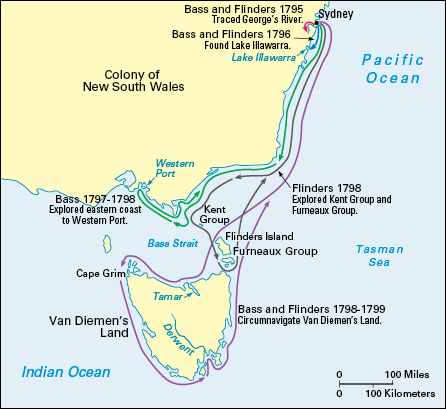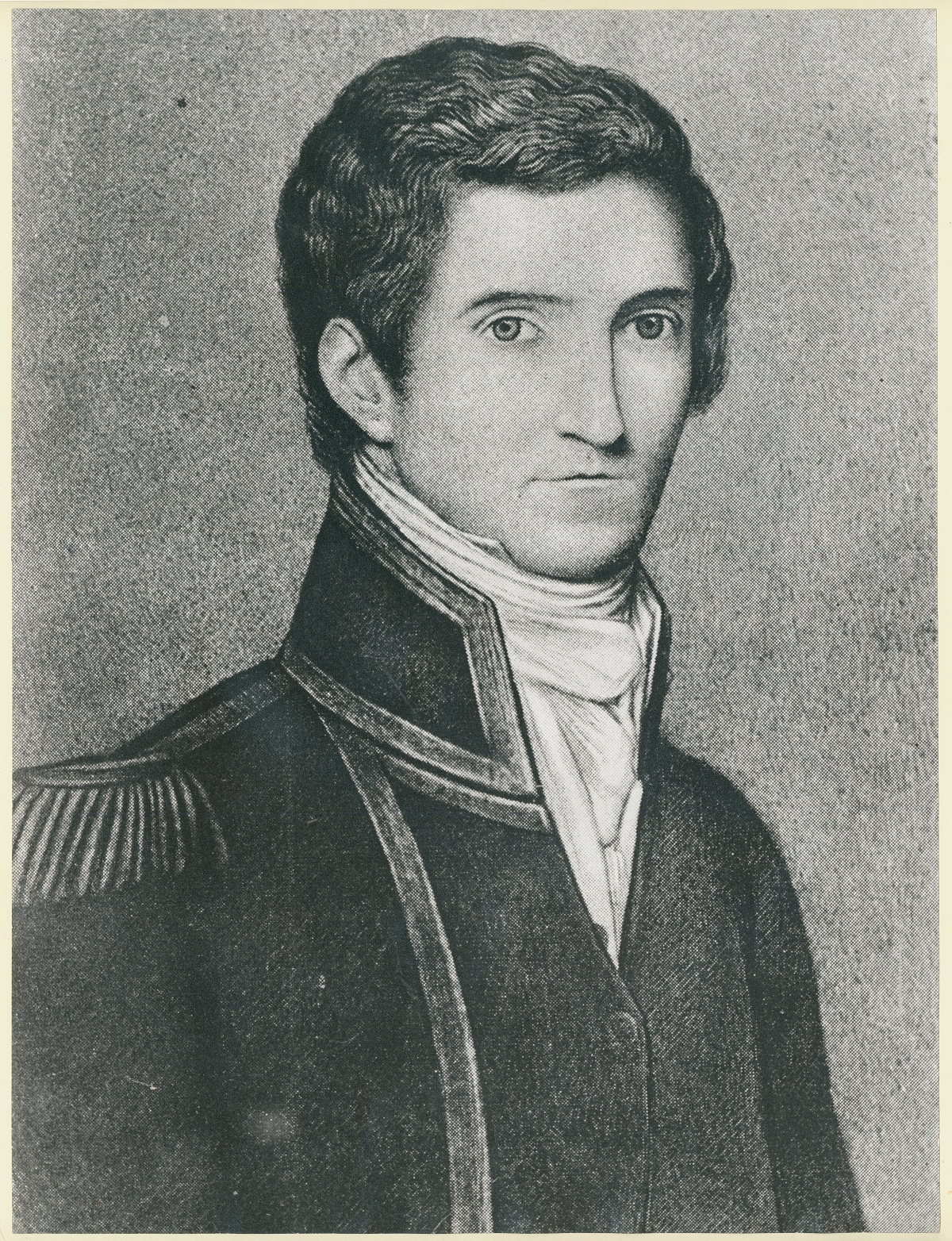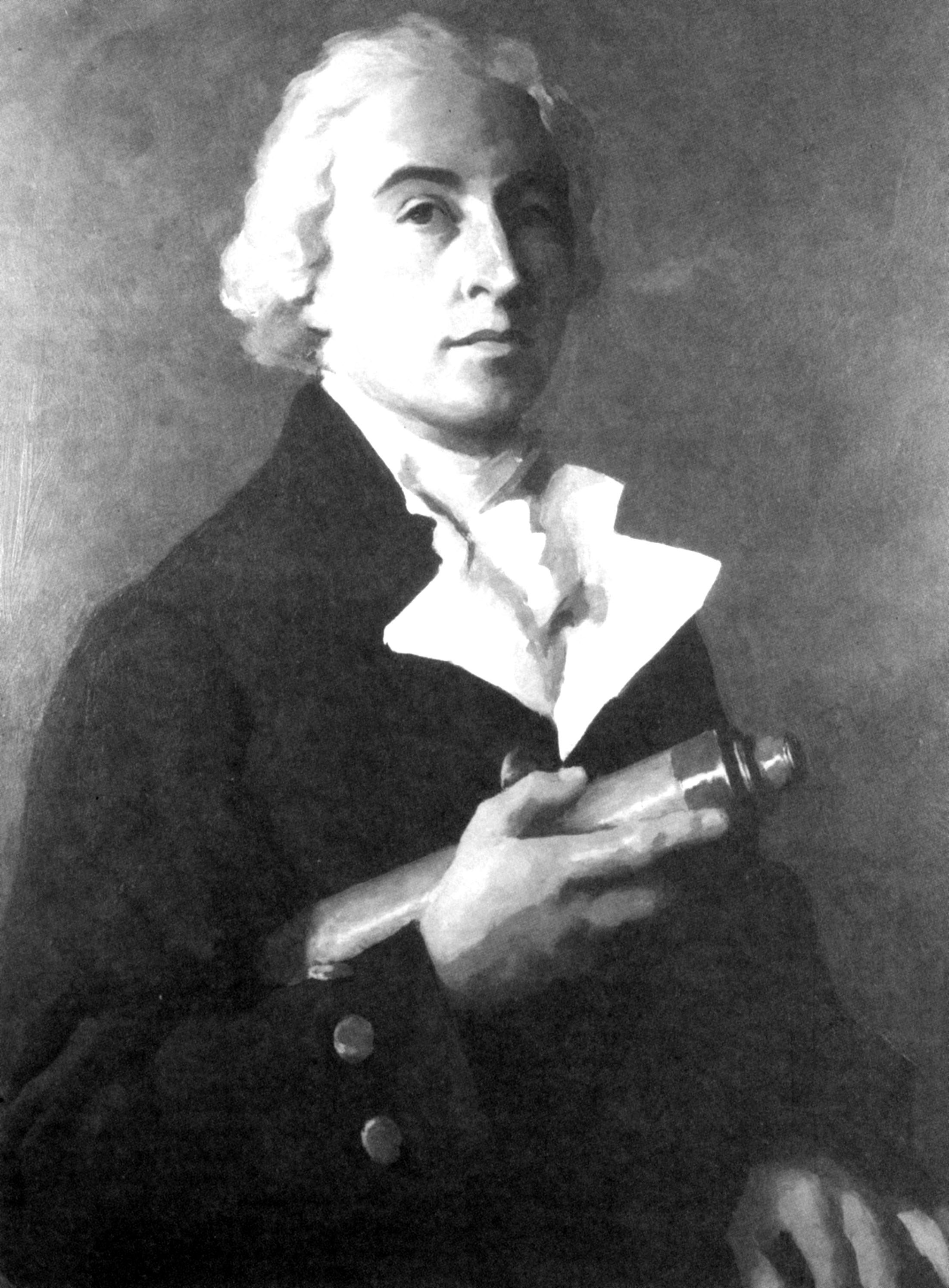Bass and Flinders were two British naval officers and explorers. Besides their individual achievements, they worked as a team to explore and chart the southeast coast of Australia. They were the first navigators to travel completely around Van Diemen’s Land (now Tasmania), proving that it is an island. In addition to their mapmaking, the pair made scientific observations of the many plants and animals they encountered.

George Bass (1771-1803?) and Matthew Flinders (1774-1814) both came from Lincolnshire, England. They met in 1795 as crew members on the H.M.S. Reliance, which was taking John Hunter to govern the British colony of New South Wales, Australia.
Flinders was the master’s mate (assistant to the navigation officer) of the Reliance, and Bass was a naval surgeon. Bass had a keen interest in exploration and brought with him an 8-foot (2.4-meter) rowboat called Tom Thumb. The two men developed a friendship during the long voyage. They reached the settlement of Sydney, Australia, in September 1795.
Voyages of the
Bass and Flinders decided to examine the east coast south of Sydney shortly after their arrival. After fitting the Tom Thumb with a mast, the pair, along with Bass’s young servant, William Martin, began exploring Botany Bay. From there, they traveled up the George’s (now spelled Georges) River, which flows into the bay. They reported their findings to Governor Hunter, who sent another party to explore the area.

Duties aboard the Reliance kept the adventurers at Norfolk Island, northeast of Sydney, for some months. In March 1796, Bass, Flinders, and Martin made another journey. This time, they took a different small boat, also called the Tom Thumb. They were searching for a river reported to be south of Botany Bay. On the second day out, a large, breaking wave beached their boat, drenching arms, ammunition, clothes, and provisions. They soon launched again. The next day, two Aboriginal men guided them to a stream where they could get fresh water and go ashore to dry their stores. As they headed up the small stream, local Aboriginal people began gathering along the banks. The Aboriginal people expressed curiosity about the European strangers. Flinders produced a pair of scissors, and the Aboriginal men allowed him to trim their beards. Near the scene of this episode, the explorers noted an expanse of inland water, which they named Tom Thumb’s Lagoon (now Lake Illawarra). 
A violent storm overtook the expedition on the way back to Sydney. They found shelter at what is now Wattamolla, in Sydney’s Royal National Park. The river they sought turned out to be an inlet into the sea. They named it Port Hacking, after the man who had first discovered it, the English explorer Henry Hacking.
Van Diemen’s Land.
In late 1797 and early 1798, Bass made a voyage without Flinders. He sailed south to what is now Wilsons Promontory, the southernmost point on the Australian mainland. At that time, it was generally believed that Van Diemen’s Land was joined to the Australian mainland. But while Bass was investigating a shipwreck in the area, his observation of tides and currents led him to suspect the existence of a strait. (A strait is an area of water, or a channel, connecting two larger bodies of water.) Flinders reached the same conclusion independently. Governor Hunter was interested in their theory and gave the two officers a chance to test it.
Together with a small crew, Bass and Flinders left Sydney’s Port Jackson on Oct. 7, 1798, in the sloop Norfolk. They reached the Furneaux Islands and headed west along the northern coast of Van Diemen’s Land. On November 3, they discovered the estuary of the Tamar River. Governor Hunter later named it Port Dalrymple, in honor of Alexander Dalrymple, an eminent English hydrographer (scientist who studies oceans, lakes, and other bodies of water).
Bass and Flinders continued westward, reaching a group of islands that Flinders named the Hunter Islands after Governor Hunter. On December 9, they noted that the flood tide was coming from the southwest. When the coast of Van Diemen’s Land curved away to the south beyond a promontory that Flinders named Cape Grim, the explorers were jubilant. Following the wild coast at a safe distance, they became the first explorers to circumnavigate (sail completely around) Tasmania. They had proved that it was an island. On the recommendation of Flinders, Governor Hunter named the passage between Van Diemen’s Land and the mainland Bass’s Strait (now Bass Strait) in honor of George Bass. On December 14, the explorers reached the Derwent River, near the site of what is now the city of Hobart, in southeastern Tasmania. The explorers returned to Sydney in January 1799.
The circumnavigation of Tasmania was the last cooperative venture for Bass and Flinders. Soon afterward, Bass went back to England, where he became interested in maritime trading. He disappeared in 1803 while on a trading voyage from Sydney to South America. Flinders returned to England in the Reliance. In 1801 and 1802, he made a circumnavigation of the Australian continent. He published several volumes of memoirs and helped popularize the name Australia. (At the time, the continent was often called New Holland.) Flinders died on July 19, 1814, in London.
